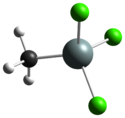Chemistry:Methyltrichlorosilane
|
| |||
| Names | |||
|---|---|---|---|
| Preferred IUPAC name
Trichloro(methyl)silane | |||
| Other names
Methyltrichlorosilane
| |||
| Identifiers | |||
3D model (JSmol)
|
|||
| ChemSpider | |||
| EC Number |
| ||
PubChem CID
|
|||
| UNII | |||
| |||
| |||
| Properties | |||
| CH3Cl3Si | |||
| Molar mass | 149.47 g·mol−1 | ||
| Appearance | Colorless liquid | ||
| Density | 1.273 g·cm−3 | ||
| Melting point | −77 °C (−107 °F; 196 K) | ||
| Boiling point | 66 °C (151 °F; 339 K) | ||
| Reacts with water | |||
| −87.45·10−6 cm3·mol−1 | |||
| Hazards | |||
| Main hazards | Highly flammable, reacts with water to release HCl | ||
| Safety data sheet | Fischer Scientific MSDS | ||
| GHS pictograms |  
| ||
| GHS Signal word | Danger | ||
| H225, H315, H319, H335 | |||
| P210, P233, P240, P241, P242, P243, P261, P264, P271, P280, P302+352, P303+361+353, P304+340, P305+351+338, P312, P321, P332+313, P337+313, P362, P370+378, P403+233, P403+235, P405, P501 | |||
| NFPA 704 (fire diamond) | |||
| Flash point | 8.0 °C (46.4 °F; 281.1 K) | ||
| 490 °C (914 °F; 763 K) | |||
Except where otherwise noted, data are given for materials in their standard state (at 25 °C [77 °F], 100 kPa). | |||
| Infobox references | |||
Methyltrichlorosilane, also known as trichloromethylsilane, is a monomer and organosilicon compound with the formula CH3SiCl3. It is a colorless liquid with a sharp odor similar to that of hydrochloric acid. As methyltrichlorosilane is a reactive compound, it is mainly used a precursor for forming various cross-linked siloxane polymers.
Preparation
Methyltrichlorosilane results from the direct process of chloromethane with elemental silicon in the presence of a copper catalyst, usually at a temperature of at least 250 °C.[1]
- 2 CH3Cl + Si → (CH3)4−nSiCln + other products
While this reaction is the standard in industrial silicone production and is nearly identical to the first direct synthesis of methyltrichlorosilane, the overall process is inefficient with respect to methyltrichlorosilane.[2] Even though dimethyldichlorosilane is usually the major product, if methyltrichlorosilane is needed, the amount of metal catalyst is reduced.[1]
Reactions
Hydrolysis and alcoholysis
Methyltrichlorosilane undergoes hydrolysis, shown in idealized form here:[1]
- MeSiCl3 + 3 H2O → MeSi(OH)3 + 3 HCl
The silanol is unstable and will eventually condense to give a polymer network:
- MeSi(OH)3 → MeSiO1.5 + 1.5 H2O
Methyltrichlorosilane undergoes alcoholysis (reaction with alcohol) to give alkoxysilanes. Methanol converts it to trimethoxymethylsilane:
- MeSiCl3 + 3 CH3OH → MeSi(OCH3)3 + 3 HCl
Reduction
Reduction of methyltrichlorosilane with alkali metals forms a highly crosslinked material called poly(methylsilyne):
- n MeSiCl3 + 3n Na →[MeSi]n + 3n NaCl
The reaction illustrates the susceptibility of silicon halides to reductive coupling. Poly(methylsilyne) is soluble in organic solvents, and can be applied to surfaces before being pyrolyzed to give the ceramic material, silicon carbide.[3]
Applications
Conversion to polymers and resins
One use for methyltrichlorosilane is in the production of methyl silicone resins (highly crosslinked polymers). Because of the stability of the cross-linked polymers resulting from condensation, the resin is stable to 550 °C in a vacuum, making it an ideal material for electrical insulation at high temperatures.[1] These resins can be used to coat computer chips or other electronic parts since they both repel water and provide thermal isolation.
Surface treatments
Methyltrichlorosilane vapor reacts with water on surfaces to give a thin layer of methylpolysiloxane, which changes the contact angle of the surface to water. This effect arises because of the oriented layer of methyl groups, making a water-repellent film.[4] Filter paper treated with methyltrichlorosilane allows organic solvents to pass through, but not water. Another benefit of such water-repellent films is that the polymers formed are stable: one of the only ways to remove the siloxane film is by acid strong enough to dissolve silicone.[4]
Reagent in organic synthesis
A combination of methyltrichlorosilane and sodium iodide can be used to cleave carbon-oxygen bonds such as methyl ethers.
- R'OR + MeSiCl3 + NaI + H2O → R'OH + RI + MeSiCl2(OH) + NaCl
Esters and lactones can also be cleaved with methyltrichlorosilane and sodium iodide to give the corresponding carboxylic acids. Acetals convert to carbonyl compounds. Thus, methyltrichlorosilane can be used to remove acetal protecting groups from carbonyl compounds under mild conditions.[5]
- RR'C(OMe)2 + MeSiCl3 + NaI → RR'CO + 2 MeI + MeSiCl2(OMe) + NaCl
Methyltrichlorosilane and sodium iodide can be used as a means of converting alcohols to their corresponding iodides; however, this reaction does not work as well with primary alcohols.[5]
- ROH + MeSiCl3 + NaI → RI + MeSiCl2(OH) + NaCl
Silicon carbide epitaxy
Methyltrichlorosilane is used as a reagent in silicon carbide epitaxy to introduce chloride in the gas phase. Chloride is used to reduce the tendency of silicon to react in the gas phase and thus to increase the growth rate of the process.[6] Methyltrichlorosilane is an alternative to HCl gas or to trichlorosilane.
References
- ↑ 1.0 1.1 1.2 1.3 Rösch, L; et al. "Silicon Compounds, Organic." Ullmann's Encyclopedia of Industrial Chemistry. Wiley-VCH, Weinheim, 2005. doi:10.1002/14356007.a24_021
- ↑ Rochow, E. The Direct Synthesis of Organosilicon Compounds. J. Am. Chem. Soc. 1945, 67, 963. doi:10.1021/ja01222a026
- ↑ Bianconi, Patricia A.; Pitcher, Michael W.; Joray, Scott. "A method of preparing poly(methyl- or ethyl-silyne) and silicon carbide ceramics therefrom." U.S. (2006), 15 pp. CODEN: USXXAM US 6989428 B1 20060124 CAN 144:129423 AN 2006:65860.
- ↑ 4.0 4.1 Rochow, E. "An Introduction to the Chemistry of the Silicones." New York: John Wiley & Sons, Inc., 1946. ISBN:1-4437-2286-3
- ↑ 5.0 5.1 Olah, G; et al. "Methyltrichlorosilane." Encyclopedia of Reagents for Organic Synthesis. New York: John Wiley & Sons, Inc., 2001. doi:10.1002/047084289X.rm265
- ↑ Bosi, M; et al. "Defect structure and strain reduction of 3C-SiC/Si layers obtained with the use of a buffer layer and methyltrichlorosilane addition" CrystEngComm 2016, 18, 2770-2779 doi: 10.1039/C6CE00280C
 |




